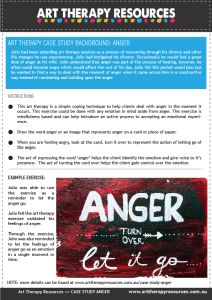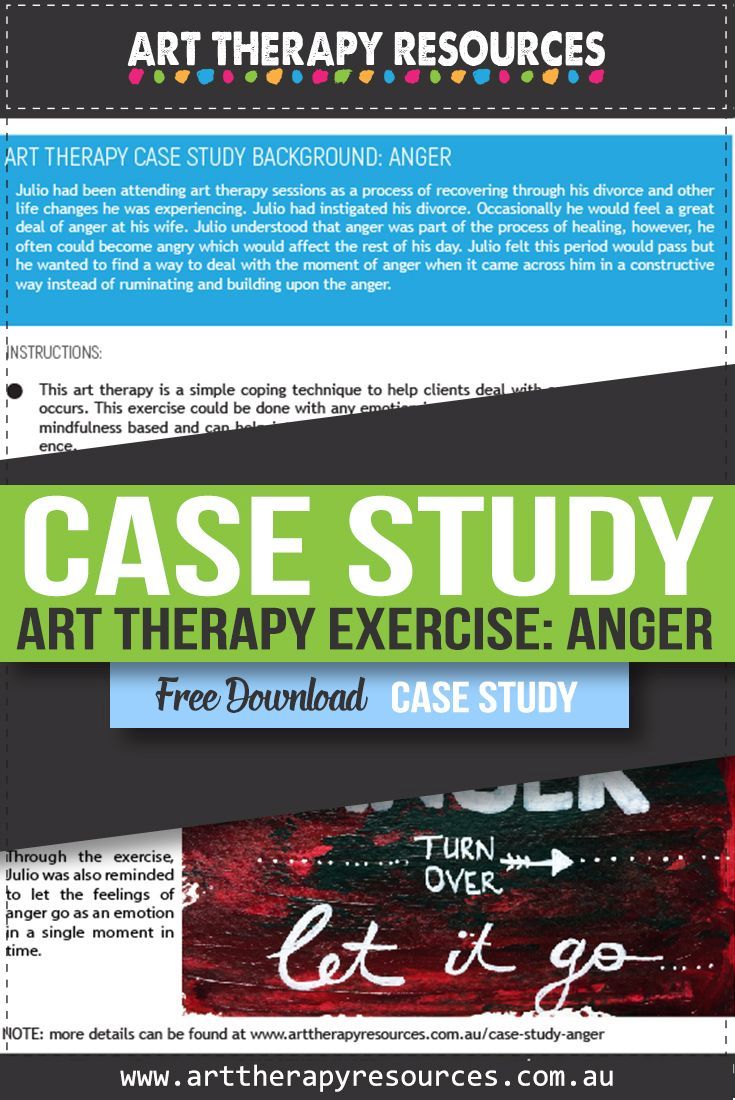THIS POST INCLUDES:
- Art Therapy and Anger
- About the Client
- Current Client Issues
- Art Therapy Exercise
- Client Insight and Outcomes
- Disclaimer
- FREE DOWNLOAD Art Therapy Exercise
ART THERAPY AND ANGER
Anger is often thought of as a volatile emotion that results in an outward expression of range and possibly violence. This can be the case in some situations, however, anger can also be expressed in a quiet and deceptively destructive manner through avoidance, resistance, and silence.
Consequently, it may be easy to address issues around anger with outwardly expressive clients, however, for some clients, it can take deeper exploration to discover the impact of personally held anger.
Anger is an emotion that is experienced across all ages and the expression of anger can differ across these age groups as individuals develop more knowledge about social norms and expression of anger and frustration.
The development of anger can stem from a wide variety of life experiences. Anger can be short lived due to a spontaneous event such as someone cutting you off in traffic or your dog chewing your favourite walking shoes, however, anger can also be pervasive and enduring due to long term events. In these experiences, anger can become an emotion that consumes a significant part of an individual’s mood.
Some examples of these enduring events are:
- Brain injuries
- Illnesses such as cancer or chronic pain
- Sexual assault
- Childhood abuse in children and adults later in life
- School or workplace bullying
- Military service
Anger is not a ‘bad’ emotion that we should seek to eliminate. Anger is our response to events that are painful and often traumatic. We respond this way on instinct in times of danger, and through our learning experiences in times of social conflict.
We can often see the extremes of handling anger by watching our parents from childhood. Anger may be loud and aggressive or stored silently with resentment.
Anger can sometimes motivate us to make necessary changes in our lives. If we are being treated poorly and remain in a situation that perpetuates that treatment, then anger can help motivate us to change that situation and improve our circumstances where we can.
In situations like these, we can see the benefit of anger to help make a transformation. Art therapy can also help in this process of transformation by welcoming the process of using our emotions, like anger, to help transform our lives.
Although anger may prove to be an impetus in some situations for positive change, it’s also not ideal for anger to be the default emotion that an individual experiences in situations. If this is the case, the individual is either experiencing a high degree of stressful life experiences (which could be a separate issue for therapy) or the individual views most life experiences as a threat to initiate anger. If anger is the prevailing emotion for many situations for an individual, this is an area that needs further exploration beyond coping techniques for isolated incidents.
HOW ART THERAPY CAN HELP WITH ANGER
Some of the common ways in which art therapy can help with the emotion of anger include:
- A helpful channel for angry emotions
- Bypass verbal communication of the reason behind anger
- Develop mindfulness skills to cope with high conflict situations
- Develops additional communication skills linked to the creative process
- Artwork can provide a ‘container’ to store the emotion of anger
- Creating art can channel the energy that anger requires into art
- Validates feelings
- Gives a physical manifestation of the emotions of anger
- Creating symbols and metaphors for anger
- Discovering hidden feelings of anger in complex situations
- Developing problem-solving skills to delay anger
ABOUT THE CLIENT
- Name: Julio
- Age: 43
- Summary of sessions to date: Julio had been attending art therapy sessions as a process of recovering through his divorce and other life changes he was experiencing.
CURRENT CLIENT ISSUES
Julio had instigated his divorce. Occasionally he would feel a great deal of anger at his wife over the past 12 months of their marriage. Julio understood that anger was part of the process of healing, however, he often could become angry which would affect the rest of his day. Julio felt this period would pass but he wanted to find a way to deal with the moment of anger when it came across him in a constructive way instead of ruminating and building upon the anger.
ART THERAPY EXERCISE
This art therapy exercise is a simple coping technique to help clients deal with anger in the moment it occurs. This exercise could be done with any emotion in mind aside from anger. This exercise is mindfulness-based and can help introduce an active process to accepting an emotional experience.
INSTRUCTIONS:
- Draw the word anger or an image that represents anger on a card or piece of paper.
- When you are feeling angry, look at the card, turn it over to represent the action of letting go of the anger.
- The act of expressing the word ‘anger’ helps the client identify the emotion and give voice to its presence.
- The act of turning the card over helps the client gain control over the emotion.
CLIENT INSIGHT AND OUTCOMES
Julio was able to use the exercise as a reminder to let the anger go. Julio felt the art therapy exercise validated his feelings of anger yet also reminded him to let the feelings go as a process of a single moment in time.

DISCLAIMER
This case study represents a snapshot of the client’s progress in treatment. The exercise in this article could be used as written or as a guide for new and original tasks developed by the Art Therapist. Responsibility for treatment resides with the individual therapist who understands their clients specific needs. The art therapy exercise should not be viewed as a pre-defined directive on how to treat a client that presents with a specific range of problems.This art therapy exercise will help build a database of knowledge to draw upon when helping your client. Art Therapy is associated with psychotherapy techniques, however each therapist often approaches therapy with their own foundation of psychological interventions, whether it be psychotherapy, CBT, DBT or other methods.
FREE DOWNLOAD: Art Therapy Exercise
Download the FREE Art Therapy Exercise based on the above Case Study. The free download includes instructions for the art therapy exercise, along with an example of the art therapy exercise.

BUILD YOUR ART THERAPY REFERENCE MATERIALS:
Pin this image to your Pinterest board.

SHARE KNOWLEDGE & PASS IT ON:
If you’ve enjoyed this post, please share it on Facebook, Twitter, Pinterest. Thank you!
